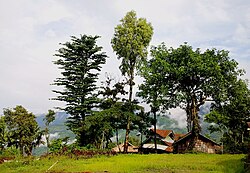Mon District
| Mon district | |
|---|---|
| District | |

Shangnyu Village, Mon district, Nagaland
|
|
 Mon district's location in Nagaland |
|
| Coordinates: 26°43′N 95°02′E / 26.717°N 95.033°ECoordinates: 26°43′N 95°02′E / 26.717°N 95.033°E | |
| State | Nagaland |
| Country | India |
| Seat | Mon |
| Population (2011) | |
| • Total | 250,671 |
| Time zone | IST (UTC+05:30) |
| ISO 3166 code | IN-NL-MN |
| Website | http://mon.nic.in/ |
Mon (Pron:/mɒn/) (Hindi: मोन ज़िला) is a district of Nagaland state in India.
Mon district is the northernmost district of Nagaland. It is bounded by the state of Arunachal Pradesh to its north, Assam to its west, Myanmar to its east, Longleng district to its south-west and Tuensang district to its south. The town of Mon is its district headquarters.
In 2006 the Ministry of Panchayati Raj named Mon one of the country's 250 most backward districts (out of a total of 640). It is one of the three districts in Nagaland currently receiving funds from the Backward Regions Grant Fund Programme (BRGF).
According to the 2011 census Mon district has a population of 250,671, roughly equal to the nation of Vanuatu. This gives it a ranking of 582nd in India (out of a total of 640). Mon has a sex ratio of 898 females for every 1000 males, and a literacy rate of 56.6%.
This district is the home of the Konyak Nagas and it is interesting to see tattooed faces wearing feathers. Konyaks are adept artisans and skilled craftsmen. Here you can find excellent wood carvings, daos (machetes), guns, gunpowder, head brushes, headgear, necklaces, etc. made by these artisans and craftsmen. The most colourful festival of the Konyaks, "Aoleang Monyu", which is observed during the first week of April every year, is a spectacle worth watching. Konyaks are the largest tribe among nagas, and speak the local language, Nagamese. They have embraced Christianity and now, Christianity has become the cohesive bond between the Nagas, who, earlier were at constant fight with each other, one who had the maximum skulls of his enemies being considered the mightiest and most powerful. Konyaks still decorate their houses with skulls, hornbill beaks, elephant tusks, horns and wooden statues.
...
Wikipedia
